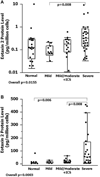Epithelial eotaxin-2 and eotaxin-3 expression: relation to asthma severity, luminal eosinophilia and age at onset
- PMID: 23015684
- PMCID: PMC3652589
- DOI: 10.1136/thoraxjnl-2012-201634
Epithelial eotaxin-2 and eotaxin-3 expression: relation to asthma severity, luminal eosinophilia and age at onset
Abstract
Background: Eosinophilic inflammation is implicated in asthma. Eotaxin 1-3 regulate eosinophil trafficking into the airways along with other chemotactic factors. However, the epithelial and bronchoalveolar lavage (BAL) cell expression of these chemokines in relation to asthma severity and eosinophilic phenotypes has not been addressed.
Objective: To measure the expression of the three eotaxin isoforms in bronchoscopically obtained samples and compare them with clinically relevant parameters between normal subjects and patients with asthma.
Methods: Normal subjects and patients with asthma of varying severity recruited through the Severe Asthma Research Program underwent clinical assessment and bronchoscopy with airway brushing and BAL. Eotaxin 1-3 mRNA/protein were measured in epithelial and BAL cells and compared with asthma severity, control and eosinophilic inflammation.
Results: Eotaxin-2 and eotaxin-3 mRNA and eotaxin-2 protein were increased in airway epithelial brushings from patients with asthma and were highest in cases of severe asthma (p values 0.0155, 0.0033 and 0.0006, respectively), with eotaxin-2 protein increased with age at onset. BAL cells normally expressed high levels of eotaxin-2 mRNA/protein but BAL fluid levels of eotaxin-2 were lowest in severe asthma. Epithelial eotaxin-2 and eotaxin-3 mRNA/protein was associated with sputum eosinophilia, lower forced expiratory volume in 1 s and more asthma exacerbations. Airway epithelial cell eotaxin-2 protein differed by asthma severity only in those with late onset disease, and tended to be highest in those with late onset eosinophilic asthma.
Conclusions: Epithelial eotaxin-2 and 3 are increased in asthma and severe asthma. Their expression may contribute to luminal migration of eosinophils, especially in later onset disease, asthma control and severity.
Figures



Comment in
-
Eotaxins may contribute to both accumulation and elimination of eosinophils in asthma.Thorax. 2013 Feb;68(2):188-9. doi: 10.1136/thoraxjnl-2012-202833. Epub 2012 Nov 26. Thorax. 2013. PMID: 23185050 No abstract available.
-
Author's response to Persson's letter.Thorax. 2013 Feb;68(2):189. doi: 10.1136/thoraxjnl-2012-202949. Thorax. 2013. PMID: 23441333 No abstract available.
References
-
- American Thoracic Society. Proceedings of the ATS workshop on refractory asthma: current understanding, recommendations, and unanswered questions. Am J Respir Crit Care Med. 2000;162:2341–2351. - PubMed
-
- Wenzel SE, Schwartz LB, Langmack EL, et al. Evidence that severe asthma can be divided pathologically into two inflammatory subtypes with distinct physiologic and clinical characteristics. Am J Respir Crit Care Med. 1999;160:1001–1008. - PubMed
-
- Miranda C, Busacker A, Balzar S, et al. Distinguishing severe asthma phenotypes: role of age at onset and eosinophilic inflammation. J Allergy Clin Immunol. 2004;113:101–108. - PubMed
-
- ten Brinke A, Zwinderman AH, Sterk PJ, et al. Factors associated with persistent airflow limitation in severe asthma. Am J Respir Crit Care Med. 2001;164:744–748. - PubMed
Publication types
MeSH terms
Substances
Grants and funding
LinkOut - more resources
Full Text Sources
Other Literature Sources
Medical
